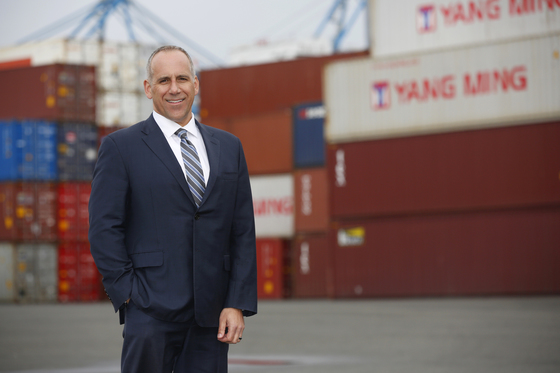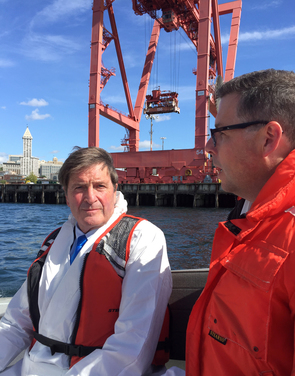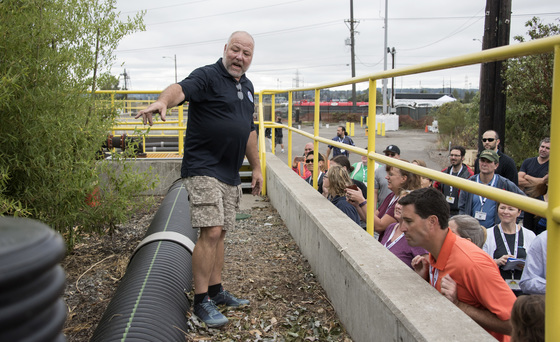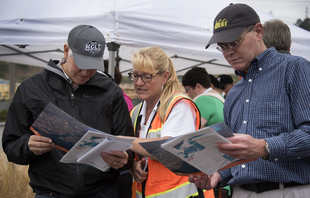In this issue:
The Managing
Members will consider an update to the NWSA greenhouse gas reduction targets at
their Oct. 3 meeting, as well as a 10-year lease agreement with Stevedoring
Services of America Terminals (SSAT) for the West Sitcum Terminal in the South
Harbor. They will also review the government affairs draft priorities for
2018. The meeting begins at 11:30 a.m. View the full agenda.
The Managing
Members will also meet on Tuesday, Oct. 24, at 10 a.m. for the NWSA Budget
Study Session. The agenda will be available online closer to the meeting.
Both
meetings will take place in room 6012M at the Conference Center at Sea-Tac
International Airport at 17801 International Blvd. in SeaTac. Meetings are streamed live
from the alliance’s website.

John Wolfe, CEO of The
Northwest Seaport Alliance, received the 2017 Connie Award presented Sept. 19 by
the Containerization & Intermodal Institute in Long Beach, California.
Since the formation of the
NWSA in August 2015, Wolfe has led the marine cargo operating partnership of
the ports of Seattle and Tacoma and guided the NWSA’s unique, customer-focused
culture.
“This is an incredible
honor for John and The Northwest Seaport Alliance,” said Tom Albro, Port of
Seattle commission president and co-chair of The Northwest Seaport Alliance.
“As the two ports took a bold step to collectively come together two years ago,
we were confident in putting John to lead an organization that would accomplish
great things.”
“John leads through hard
work and a well-grounded vision. He is someone who is easy to trust and has the
ability to see the big picture,” said Dick Marzano, Port of Tacoma commission
president and co-chair of the NWSA. “We can’t think of anyone more deserving of
the Connie Award.”
Wolfe also serves as the
chief executive officer of the Port of Tacoma.
Connie recipients are
recognized each year for “outstanding contributions to containerization and
world trade and transportation sector and are acknowledged for their pioneering
spirit in their careers, as well as for the positive example they establish for
those who will be the future the industry.”

The Northwest Seaport
Alliance’s total year-to-date container volumes through August increased 5
percent while total monthly volumes for the gateway improved 6 percent over
August 2016.
Full imports
for the month of August reached their highest level since 2010, increasing 1
percent to 119,529 TEUs (20-foot equivalent units) compared to last year. Full
exports were down 8 percent to 76,614 TEUs. Empty exports, reaching their
highest volume since 2006, grew 58 percent as ocean carriers continued to
reposition containers to Asia to keep pace with peak-season demand.
Year to date,
full import volumes were up 5 percent to 922,886 TEUs, the fourth-highest on
record. Meanwhile, full exports were down 1 percent at 616,957 TEUs. Total
international container volume, including empties, increased 9 percent year to
date to 1,963,419 TEUs, the highest YTD volume through August since 2007.
Total domestic
volumes for the month increased 6 percent compared to the same month last year.
Alaska’s year-to-date volumes were down 7 percent and are expected to end the
year 8 percent lower than 2016 due to soft market conditions. Hawaii volumes
through the Pacific Northwest are down 2 percent year-to-date due to diversion
to Southern California.
Other cargo:
- Driven by consistent demand from
China, log volumes continue to grow. They were up 101 percent to 186,582
metric tons year to date compared with the same period last year.
- Breakbulk cargo volume was down 3
percent to 125,030 metric tons year to date due to soft market conditions.
- Autos, at 96,962 units year to
date, were down 19 percent compared to the same period last year,
reflecting weakening U.S. demand and shifting manufacturing locations.
View
the August 2017 cargo reports:
|


We
hosted Commissioner Dan Maffei (above) of the Federal Maritime Commission at the North
Harbor earlier this month. He got to see how we are preparing to handle
multiple ultra-large container ships simultaneously, including modernizing
Terminal 5 and deepening
the Seattle harbor.
We also welcomed Congressman
John Garamendi of California (right), the ranking member of the House
Transportation and Infrastructure Subcommittee on Coast Guard and Maritime
Transportation.
In addition to seeing the Terminal 5 modernization project,
Garamendi also heard about the need for the Harbor Maintenance Tax reform to keep U.S. ports competitive.
|


We showed off the NWSA’s award-winning
biofiltration stormwater treatment system at the West Hylebos Log Yard to a
group of public officials and civil engineers from across the country. The tour
was held in late August as a part of StormCon, the world's largest conference for surface
water quality professionals.
The bioretention system in the South Harbor was installed
in 2013 and helps remove toxic pollutants from stormwater at the log yard. The
infrastructures are filled with compost and gravely sand and are home to two
types of bamboo and 30 different kinds of grass and sedges.
|

According to the National
Onion Association, onions are one of the world’s most versatile vegetables.
Onions can be found in a wide-range of recipes from breakfast to dinner and in
nearly every world cuisine. Onions are the third most consumed fresh vegetable
in the U.S. behind potatoes and tomatoes.
The U.S. per capita
consumption of onions is about 20 pounds per year. This translates to more than
450 semi-truck loads of onions used in the United States each day. The top
three onion producing areas in the United States are Idaho-Eastern Oregon, Washington
and California. U.S. onion exports amount to 11 million to 14 million 50-pound
bags per year. Leading export countries from the U.S. are Taiwan and Japan.
The U.S. also imports
onions totaling 16 million to 20 million 50-pound bags annually. Leading
countries importing into the U.S. are Mexico, Canada, Peru and Chile.
Did
you know?
The average American eats 20 pounds of fresh and
storage-type onions per year. Libya has the highest per-capita consumption of
onions at 66.8 pounds per person each year.
For other fun facts, visit
the National Onion Association.
|
|